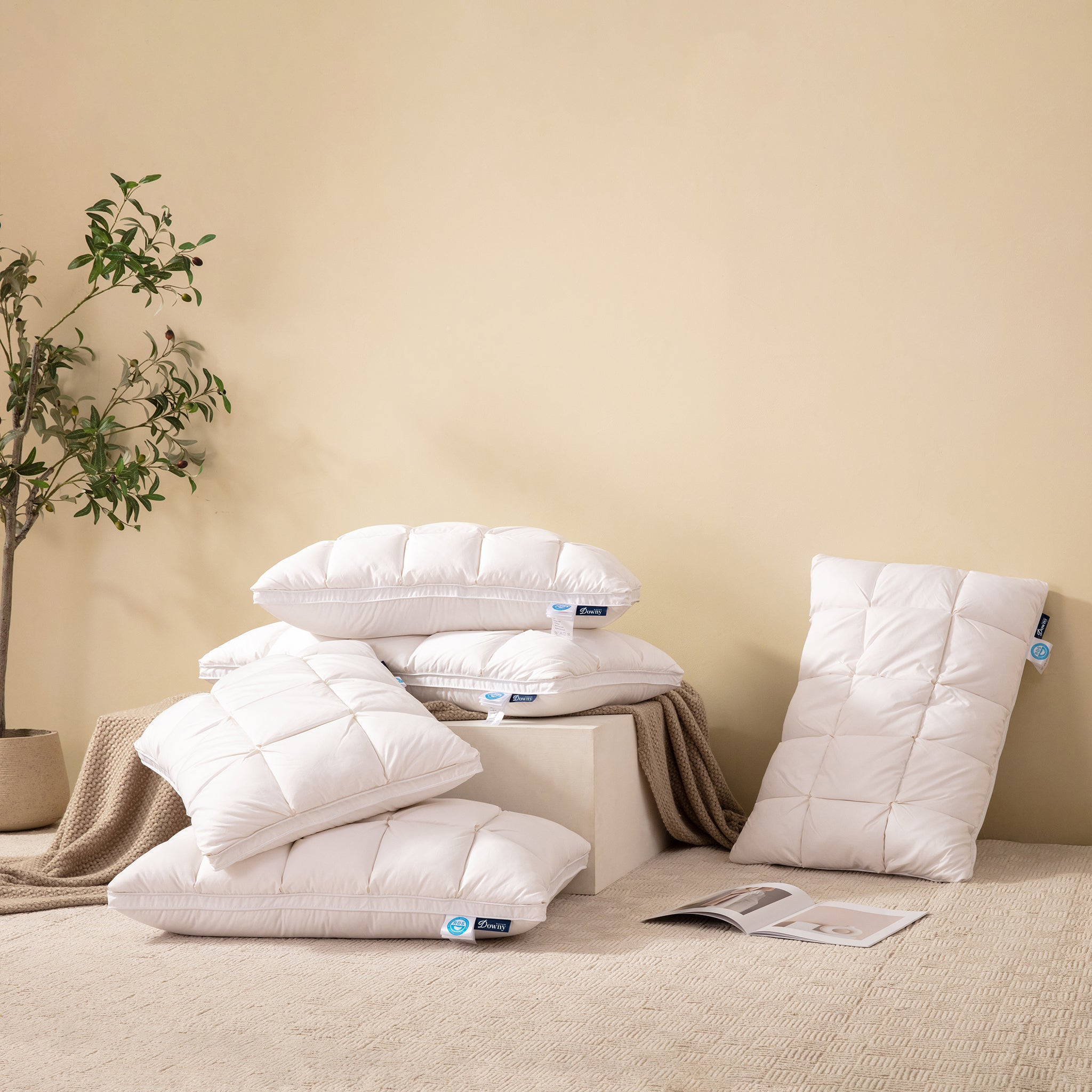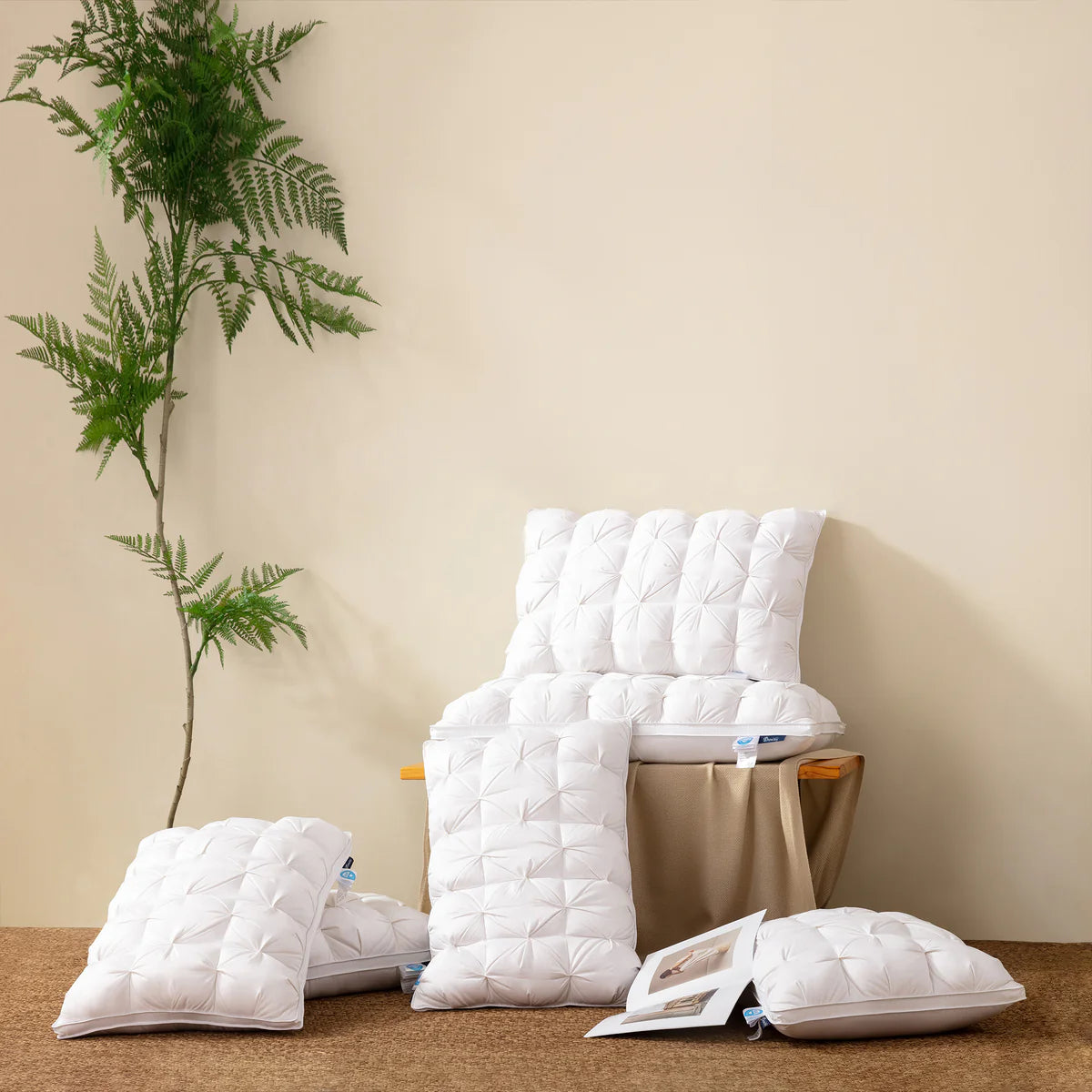Down pillows are popular for their softness, comfort, and ability to conform to the shape of your head and neck. Choosing the right down pillow can lead to a better night's sleep. This article will cover the key factors to consider when selecting a down pillow, including fill power, construction, firmness level, allergy concerns, ethical sourcing, care, price, and reviews. We'll outline the pros and cons of down pillows to help you determine if one is right for your needs. By the end, you'll have the information you need to confidently choose a down pillow that provides the comfort and support you want.
Pros and Cons of Down Pillows

Down pillows are known for being incredibly soft and moldable. The down filling shifts to cradle your head and neck, providing customized support. This makes down pillows preferable for side and stomach sleepers. The down fill is also very durable, maintaining loft and resilience for many years with proper care.
On the downside, down pillows tend to be more expensive than synthetic options. They also pose allergy risks for those sensitive to down and feathers. There are also ethical concerns around sourcing down humanely. However, many brands like us now use Responsible Down Standard (RDS) certified down. This ensures the down does not come from force-fed or live-plucked birds.
Overall, down pillows excel in providing plush comfort and longevity. But the higher price tag, allergy risks and ethical sourcing issues are factors to weigh. However, here at Downyhaven, you don't need to worry this issue as we have our own factory and farm to ensure all the down feathers are collected ethically.
Fill Power
Fill power is the most important factor to consider when choosing a down pillow. It refers to the loft or "fluffiness" of the down filling inside the pillow. Fill power is measured in cubic inches per ounce. The higher the fill power, the more air pockets trapped between the down clusters, creating more loft and a lighter feel.
Down with a higher fill power of 800 and above is considered superior quality. The more air pockets within the down, the more the pillow can compress and spring back into shape. Fill power ranges from 300 to 1000, with most high-quality down pillows falling between 600 to 800 fill power.
The higher the fill power, the more insulating and durable the pillow. 800 fill power down will not become flat and compressed like a 300 fill power pillow over time. While higher fill power costs more, it's worth investing in for long-lasting comfort and support.
The best down pillows use 100% down. Lower quality pillows add feathers which are heavier and don't provide the same soft, cloud-like feel. Avoid pillows labeled as "down blend" or "down alternative", as these contain synthetic fibers and not true down. Always check the fill power to determine the down quality inside your pillow.
Construction

When choosing a down pillow, pay close attention to the construction. This includes the cover fabric, stitching, and interior chambers. Here at Downyhaven, we have particularly designed the cover pattern with top notch fabric and ensured each stich is consistent and sturdy.
Cover Fabric
The cover fabric is important for comfort and durability. High quality down pillows have covers made from soft, breathable fabrics like cotton or cotton blends. Avoid cheaper synthetics like polyester, which can make you sweat at night. The thread count of the fabric also matters - the higher the thread count, the softer and more durable the cover will be. Look for a minimum thread count of 200.
Stitching
Make sure to inspect the stitching on a down pillow carefully before purchasing. High quality stitching keeps the fill in place and prevents the pillow from going flat. Tightly sewn seams with small, consistent stitching indicate good craftsmanship. Avoid down pillows with loose, uneven stitching, which allows the fill to shift around inside.
Chambers
Down pillows contain interior baffles or chambers that compartmentalize the fill. More chambers provide more support for your head and neck. Look for a minimum of 300 thread count all-cotton fabric and baffles to keep the fill in place. Down proof stitching prevents the delicate fill from poking through. Well-constructed chambers also allow you to adjust fill between sides for personalized comfort and support.
Firmness Level
When choosing a down pillow, one of the most important factors to consider is the firmness level. Down pillows come in a range of firmness options, from very soft and fluffy to extra firm. The firmness you choose depends largely on your sleeping position and personal preference.
Firm vs Soft
-
Firm down pillows provide more support and are recommended for back and stomach sleepers. The firmer fill keeps the head elevated and prevents it from sinking into the pillow. This helps maintain proper spinal alignment.
-
Soft down pillows contour more closely to the head and neck. Side sleepers often prefer softer pillows that cushion pressure points while allowing the head to sink in slightly. Soft down is also ideal if you simply like a fluffier feel.
Firmness Scale
Down pillow firmness is measured on the following scale:
-
Very Soft: Perfect for side sleepers who want maximum moldability and head/neck cushioning. Not enough loft for back sleepers.
-
Medium Soft: Versatile comfort and support for most sleep positions. Cradles the head gently.
-
Soft: Provides some sinkage and contouring for side sleepers. Usually too soft if you sleep on your back.
-
Medium Firm: Firmer with excellent support for back sleepers. Also accommodates combination sleepers.
-
Firm: Very supportive for back and stomach sleepers. Keeps the spine aligned.
-
Extra Firm: Maximum elevation and support preferred by some stomach sleepers. May feel too hard for side sleepers.
However here at Downyhaven, we have made 2 extra soft series, they are Velvety soft and Ultra-soft. Please check out our pillow guide for details.
Stomach vs Side Sleepers
Stomach sleepers require firmer support to keep the head and neck aligned with the rest of the spine. Avoid pillows that are too soft or thin which can cause neck pain.
Side sleepers need a softer pillow that cushions the head and shoulders. A pillow that's too firm or thick can lead to pressure points in the neck and shoulders.
Try out pillows in different firmnesses to find the right balance of comfort and support for your sleep position. The ideal loft also depends on your body type and size.
Allergies
Down pillows are filled with feathers from ducks or geese, which can trigger allergic reactions in some people. The most common allergy concern with down pillows is dust mites. Dust mites feed on skin cells that accumulate in the pillow over time. Their feces and decaying bodies can cause allergic reactions in sensitive individuals.
Some steps can be taken to reduce allergens in down pillows:
-
Wash the pillow frequently using hot water to kill dust mites. Use a hypoallergenic detergent that is fragrance free.
-
Use pillow protectors and pillow cases made from tightly woven fabric to prevent dust mites from getting into the pillow.
-
Replace down pillows regularly, as they can't be washed indefinitely.
-
Consider using a hypoallergenic down alternative pillow if feather allergies are a major concern. These are filled with hypoallergenic synthetic fibers instead of down.
-
Allergy sufferers may want to avoid down pillows altogether and opt for a synthetic pillow with a hypoallergenic fill like polyester.
-
Look for down pillows certified as hypoallergenic. They undergo extra washing and processing to remove the majority of allergens. However, no down pillow can ever be 100% hypoallergenic.
With some care and precautions, down pillows can still be an option for those with mild to moderate allergies. But people with severe allergies are better off avoiding down and feathers altogether.
Care
Taking proper care of your down pillow can help extend its lifespan. Here are some tips for washing, fluffing, and storing your down pillow:
Washing
-
Check the care tag on your down pillow for specific washing instructions. In general, down pillows should be washed every 6 months to 1 year to remove oils, sweat, and dust mites.
-
Use a front-loading washing machine for best results. Top-loading agitator washers can damage down pillows. Set the washing machine to a gentle/delicate cycle using cold water.
-
Use a mild detergent made specifically for down. Regular detergents can strip the natural oils from down. Avoid using bleach or fabric softeners.
-
After washing, use the spin cycle to remove excess water. Do not wring or twist the pillow.
Fluffing
-
Fluff your pillow daily to redistribute the down and plump it back up. Gently knead the pillow with your hands to break up any clumps.
-
Stand the pillow upright and pound it gently on a flat surface. This will loosen compressed areas.
-
Use a tennis ball in the dryer. Throw a couple clean tennis balls in the dryer with the pillow on air fluff or no heat. The balls will help break up clumped down.
Storage
-
Store down pillows in a breathable cotton pillow protector to prevent dust mites but allow airflow.
-
Avoid plastic bags or containers that prevent airflow and could create moisture.
-
Store in a cool, dry place like a closet. Heat and humidity can damage down.
-
When not in use, store down pillows fully fluffed up rather than compressed to maintain loft.
Price
Down pillows can range greatly in price depending on the fill power, construction quality, and brand. Here are some general price ranges:
-
Budget ($20-$50): The most affordable down pillows are often lower fill power around 500-550 fill power. They may be bargain/generic brands with poly-cotton shell fabric. Can find deals at discount home stores.
-
Mid-range ($50-$150): The mid-range offers good quality pillows with shell fabrics like 300-600 thread count cotton. Fill power around 600-800. Here we recommend TwistComfort and BlissfulCloud. Both are pure down pillows with densible 750 fill power yet with different design pattern.
-
Premium ($150-$300+): Luxury and high-end down pillows over 800 fill power with premium shell fabrics like Egyptian cotton. Our luxury goose down pillows include Hotel Suite Goose Down Pillow and Royal Comfort.
The best value is often found in the mid-range pillows, offering good quality materials without the ultra premium pricing. However, here at Downyhaven, we have our own factory and geese farms to ensure both quality and prices are great for you!
Conclusion
Getting youself an ideal down pillow does need to break your bank! Here at Downyhaven, we are aim to provide you with quality down pillows at affordable prices!



